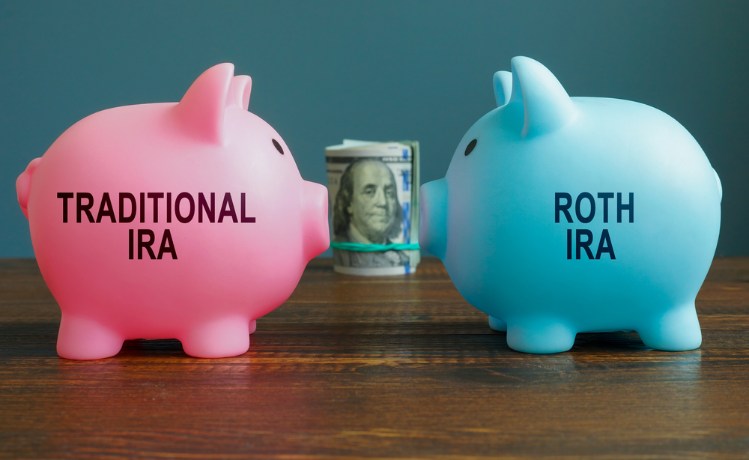Traditional vs. Roth IRA
For years, the debate as to which Individual Retirement Plan (IRA) is better has raged on, especially considering the implications for younger savers. Which should you choose? The Traditional IRA or the Roth IRA? There are many similarities between the two options, but there are also some major distinctions that you should be aware of when choosing which is better for you.
- IRAs are retirement investment vehicles that anyone with earned income can contribute to
- The main difference between traditional and Roth IRAs are when taxes are due
- If you prefer an immediate tax break, go traditional! If you’d rather enjoy tax-free distributions during retirement, go Roth!
What is an IRA?
Let’s start with a basic definition of an IRA. Put simply, an IRA is a retirement account that can be opened and contributed to any year you have earned income. Earned income can include your salary from a job, self-employment income, independent contractor income, combat pay, or a spouse’s income. Some income is not considered earned, such as pensions, annuities, interest & dividends and rental income.
The most important feature of an IRA is the ability to help save for retirement on a tax-deferred or tax-free basis. The corollary to these tax benefits is that since IRA funds are earmarked for retirement, there are generally severe penalties for withdrawing money early. IRAs are available at just about every financial institution in the country, including banks, brokers, and mutual fund companies.
What is a Traditional IRA?
A traditional IRA (sometimes called a pretax IRA) is the most common choice for most savers. It is funded with pretax money and allows for a tax deduction in the years the contribution was made. The IRS limits the amount you can annually contribute to an IRA. For 2023, you can contribute up to $6,500 ($7,500 for participants age 50 and above) or the total amount of earned income for the year, whichever is less.
Your IRA gains are tax-deferred and are only taxed when you take distributions during retirement. Traditional plans are also subject to Required Minimum Distributions rules (RMD). Under the RMD rules, once you turn 73, you MUST start taking distributions, whether you want to or not. The minimum required amount is determined by the IRS using your IRA balance and your age.
Distributions taken before the participant turns 59 ½ are subject to tax and a 10% early withdrawal penalty, but there are exception to this penalty known as “hardship withdrawals.” Under one of these exceptions, you will not be penalized if you:
- Withdraw money for higher education expenses (for yourself and immediate family);
- Make withdrawals for a first-time home purchase (up to $10,000 for your lifetime);
- Use the withdrawal for medical expenses or health insurance; or
- If you become disabled or pass away.
Read the IRS Exception on Tax and Early Distributions for a full explanation of exceptions to the early withdrawal penalty.
What is a Roth IRA?
A Roth IRA is a type of IRA created in 1997. The Roth IRA differs from a traditional plan in several ways. Most importantly, a Roth IRA is funded with after-tax dollars, meaning you don’t get an upfront tax deduction when making a Roth IRA contribution. However, all qualified distributions from the plan are tax-free! This is the major advantage of the Roth IRA over the traditional IRA. So long as you are over the age of 59 ½ and the Roth IRA has been opened at least 5 years, all Roth IRA distributions are tax-free!
While contribution limits mirror a traditional IRA, there are income limits which restrict high earners from directly contributing to a Roth IRA.
Single filers
In 2023, single filers may contribute fully to a Roth IRA if their earned income is less than $138,000. Beyond that, contributions are phased out until earned income exceeds $153,000. If you earned more than this $153,000, you cannot contribute to a Roth IRA.
Married filing jointly
In 2023, if you are married and file your taxes jointly, you may contribute fully to a Roth IRA if your earned income is less than $218,000. Contributions are phased out up until $228,000. If you earned more than this amount, you cannot contribute to a Roth IRA.
The Backdoor Roth IRA
Since 2010, the IRS eliminated income restrictions for making Roth contributions, opening the door to more investors. Therefore, in 2023, anyone can make a Roth IRA contribution either directly or via a Backdoor Roth IRA, no matter what your income is. A Backdoor Roth IRA is a two-step process: first, the IRA owned contributes to a traditional IRA (after-tax) and then immediately converting it to a Roth IRA. Since the IRA owner never took a deduction for the after-tax Traditional IRA contribution, the conversion to Roth IRA would not be subject to tax at all.
Another major difference is that Roth IRAs are not subject to RMDs, meaning that because you already paid taxes on your Roth contributions, the IRS does not require you to withdraw money from the plan at any time. One primary benefit of a Roth IRA is that you can pass on the plan to your beneficiary fully intact. In addition, no age restrictions apply to Roth contributions. If you have earned income, you can continue to contribute to a Roth IRA, even after age 73.
Roth plans also give you the ability to withdraw your contributions at any time and for any reason, typically without taxes or penalties. One caveat to that rule is when your distribution is higher than the amount you’ve contributed to the plan (plus earnings). In this situation, the earnings may be subject to penalties as an unqualified distribution. Just as with traditional IRAs, certain hardships exceptions allow for withdrawals without penalties.
Which do you prefer and why: The Traditional IRA or Roth IRA?
Each plan offers several benefits, along with some potential drawbacks. Depending on your specific situation, either may be the better option. Here’s a simple breakdown of the pros and cons:
Traditional IRA
- Funded with pretax money – Receive a tax break now!
- Taxes are deferred – You don’t pay taxes until you start taking distributions during retirement.
- Bump down a tax bracket – If you are on the cusp of a higher tax bracket, making a traditional contribution may keep you in the lower bracket.
- No income restrictions – It doesn’t matter how much you earn; you can always contribute to a Traditional IRA, even if some high earners may not receive the tax deduction.
- RMD – You must start withdrawing from the plan once you reach age 73.
note: As of 2020, you can still contribute to a traditional plan even after you reach the RMD age
Roth IRA
- Funded with after-tax money – No immediate tax break.
- Tax-free Distributions – All distributions are tax-free during retirement.
- Income Restrictions – If you earn too much money, you cannot contribute to a Roth (though you can still use the Backdoor Roth IRA).
- No RMD – You are never forced to take money from your Roth plan.
- No Age Limit – You can contribute to a Roth during any year you have earned income, regardless of your age.
- Emergency Fund – Withdraw contributions at any time without penalty.
The choice between a Traditional and Roth IRA is a complex one and is typically very fact dependent on an individual’s situation. As you can see, there are several differences (and similarities) between the two plans. Roth plans are generally better suited towards younger individuals who benefit more from tax-free withdrawals. Traditional plans offer high earners a way to save on taxes right now. The only way you can go wrong is by not contributing to either of them.
For more advice about your specific situation, contact an IRA Expert @ 800.472.0646.













